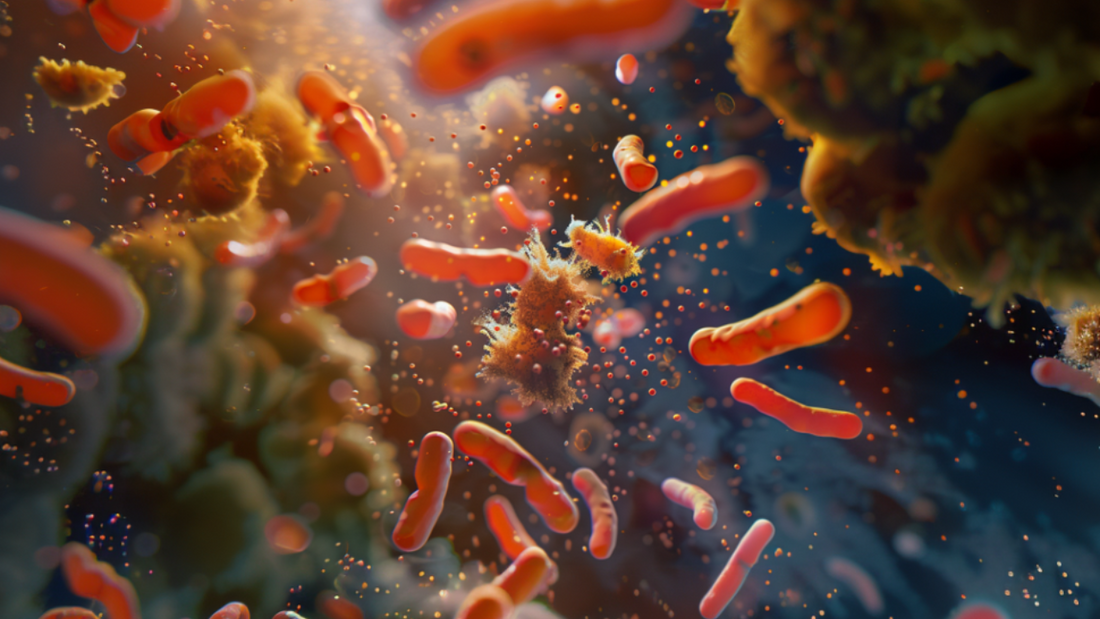Understanding Biofilms and Biofilm Disruptors: Support for SIBO, UTIs, and More

Share
Disclaimer: This content is for informational purposes only and does not constitute medical advice. Zuma Nutrition’s products are dietary supplements, not intended to diagnose, treat, cure, or prevent any disease. Consult a healthcare professional before making changes to your health regimen.
What Are Biofilms?
Biofilms are groups of microorganisms that band together, sticking to surfaces and encasing themselves in a protective layer called the extracellular polymeric substance (EPS). This matrix, made of sugars, proteins, and DNA, acts like a shield, making biofilms resistant to antibiotics and the body’s immune defenses.
Biofilms can form on various surfaces, such as:
-
Medical devices (e.g., catheters, implants)
-
Natural tissues (e.g., in the gut or urinary tract)
-
Industrial equipment
Because biofilms are up to 1,000 times more resistant to antimicrobials than free-floating bacteria, they’re a major factor in chronic infections, including SIBO, UTIs, and wound infections.
What Are Biofilm Disruptors?
Biofilm disruptors are substances that weaken or break down the biofilm matrix, exposing bacteria to antibiotics, immune responses, or other treatments. These can include synthetic compounds, enzymes, or natural ingredients. By disrupting the biofilm, these agents may improve the effectiveness of antimicrobial therapies, though results depend on the specific condition and treatment plan.
Biofilm Disruptors to Know
Below are some biofilm disruptors backed by research. While promising, their effectiveness varies, and they should be used under medical supervision.
1. N-Acetylcysteine (NAC)
NAC is an antioxidant and mucolytic (mucus-thinning) agent. Studies suggest it may break down biofilms formed by bacteria like Pseudomonas aeruginosa and Staphylococcus aureus by degrading their matrix. It may enhance antibiotic effectiveness but can cause side effects like nausea in some people.
2. EDTA
EDTA is a chelating agent that binds metal ions critical to biofilm stability. Research indicates it may weaken biofilms, making bacteria more susceptible to treatment. However, high doses can affect calcium levels, so medical oversight is essential.
3. Xylitol
Xylitol, a natural sugar alcohol, may prevent bacteria from sticking to surfaces and forming biofilms. Studies show it could support antibiotic action, especially for oral or respiratory infections. It’s generally well-tolerated but should be used as part of a broader treatment plan.
4. Enzymes
Enzymes like DNase I and proteases target specific biofilm components, such as DNA or proteins. Research suggests they may disrupt biofilms from various bacteria, though they’re typically used in clinical settings under professional guidance.
Natural Biofilm Disruptors
For those exploring natural options, some plant-based compounds show promise as biofilm disruptors. These should complement, not replace, medical treatments.
1. Garlic Extract
Garlic contains allicin, which research suggests may disrupt biofilms from bacteria like Escherichia coli and Staphylococcus aureus. It’s a traditional remedy with antimicrobial properties but may interact with medications.
2. Cranberry Extract
Cranberry’s proanthocyanidins may prevent bacteria like E. coli from adhering to the urinary tract, reducing biofilm formation. It’s commonly used to support UTI prevention, though it’s not a cure.
3. Oregano Oil
Oregano oil, rich in carvacrol and thymol, may disrupt biofilms and enhance antibiotic effects, per studies on Candida albicans and other pathogens. It’s potent, so use it cautiously and under guidance.
4. Manuka Honey
Manuka honey has unique antimicrobial properties that may weaken biofilms from Staphylococcus aureus and Pseudomonas aeruginosa. It’s often used topically or as a supplement but requires careful dosing.
5. Berberine (from Oregon Grape Root or Goldenseal)
Berberine, found in herbs like Oregon grape root and goldenseal, may inhibit biofilm formation and bacterial growth. It’s traditionally used for infections but can cause digestive upset in some cases.
Note: Natural products are not FDA-approved to treat or cure any condition. Their safety and efficacy depend on individual health and proper use.
Biofilm Disruptors for Specific Conditions
Certain disruptors may be more relevant for specific infections, but always follow a healthcare provider’s advice.
For SIBO
SIBO involves bacterial overgrowth in the small intestine, often protected by biofilms. Disruptors like NAC, garlic extract, and oregano oil may support treatment by breaking down biofilms, potentially improving antibiotic or herbal antimicrobial outcomes. Treatment typically lasts 4–8 weeks, depending on severity.
For UTIs
UTIs, often caused by E. coli, can involve biofilms that make infections recurrent. Cranberry extract, xylitol, and Manuka honey may help prevent biofilm formation or support antibiotic action. Treatment duration is usually 1–2 weeks, though recurrent UTIs may require longer or repeated courses.
How to Use Biofilm Disruptors Safely
Biofilm disruptors are often used alongside antibiotics, herbal antimicrobials, or probiotics for a comprehensive approach. Here’s how to integrate them effectively:
-
With Antibiotics: Disruptors may improve antibiotic penetration into biofilms, but timing and dosing must be coordinated by a doctor.
-
With Herbal Antimicrobials: Herbs like berberine or neem can complement disruptors for a natural approach.
-
With Probiotics: Probiotics may restore healthy gut bacteria, supporting recovery and preventing reinfection.
Treatment Duration
-
SIBO: 4–8 weeks, alongside antimicrobials, with regular symptom monitoring.
-
UTIs: 1–2 weeks, depending on infection severity. Recurrent cases may need extended treatment.
Safety Considerations
-
Side Effects: NAC may cause nausea; EDTA can affect calcium levels; natural compounds like oregano oil may irritate the stomach.
-
Interactions: Some disruptors, like garlic or berberine, may interact with medications.
-
Monitoring: Regular check-ins with a healthcare provider ensure safety and effectiveness.